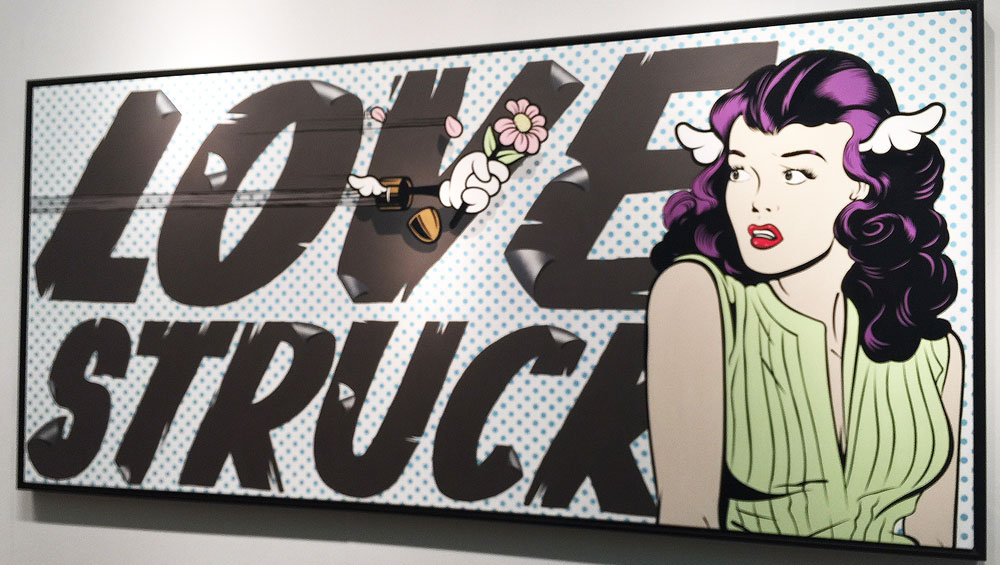
D*Face. Love Struck. Enamel and pigment-based paint on canvas. Photograph: Jill Spalding.
Frieze New York
Randall’s Island Park, New York
3-6 May 2018
Tefaf New York Spring
Park Avenue Armory
4-8 May 2018
by JILL SPALDING
A sweltering heat and art dealer jitters about a softening market did not discourage attendance at the Frieze fair’s four-day celebration of art as big business. Had you ferried to Randall Island past the Black Lives Matter flag that Adam Pendleton had planted at the once-designated “Negro Point” and alongside Hank Willis Thomas’s hand-embroidered “bars and stars” lives-lost-to gun-violence riff on the American flag, you might have anticipated a political take on this socially fraught moment. Indeed, there was no shortage of activist commentary – on deracination, poverty, injustice and war – but the overriding takeaway turned out to be appealingly various; joyous and sexy, enigmatic and obvious, grounded and, I have to say, bouncy.
Orientation was a challenge; replacing the serpentine, parallel-lane tent, five interlocking tents lodged 195 galleries from 30 countries in what new director Victoria Siddall intended as a “village”. Whether looking over her shoulder to the more intimate Tefaf Spring, or forward to the much smaller first edition of Frieze Los Angeles 2019, her idea was to create interacting isles of visual stimulus informed by a cluster of new material (Frame), younger galleries (Focus) and underappreciated artists (Spotlight), so as to energize and broaden the experience of art.
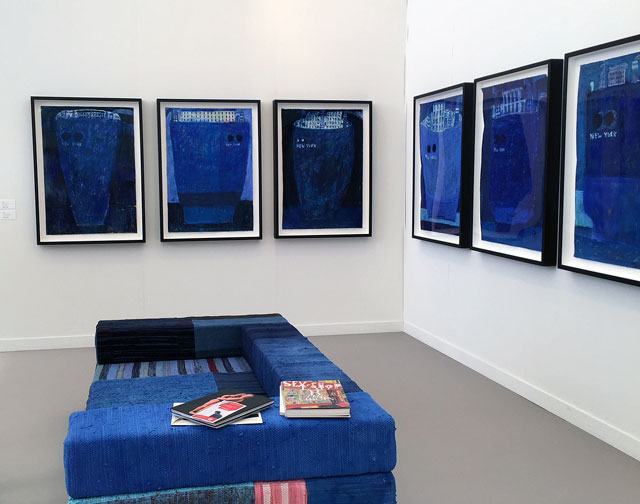
Tal R. A ship called New York, 2017. Installation view. Photograph: Jill Spalding.
Tellingly, though, the established collectors I ran into were touring the risk-averse mega-dealers for their investment-guaranteed offerings. Assuring quick sales well exceeding the lowered $20,000 benchmark, the all-stars Tony Cragg, Robert Mapplethorpe, Philip Guston, Mariko Mori, Antony Gormley, Tracey Emin and Kehinde Wiley all sold by day’s end. Painting predominated, both abstract and figurative. I passed by a startling number of thickly painted canvases embedding shards and small objects, but spent a long moment at Ghebaly, delighting in talented young Franco-Belgian painter Farah Atassi’s allusive geometries, whose synthetic vocabulary vacillates between signage and figuration. And there was no ignoring Tal R’s comment on city culture, A ship called New York (Cheim & Read), a cobalt assemblage fronting a sofa against a series of large paintings on paper.
More appealing to the fledgling collectors and young-young crowd pouring in were the quirkier installations, conversation-piece word, neon and mirror works and the performance pieces parading down the aisles (who knew you could actually collect them in the form of proprietary documents detailing movements and garb?).
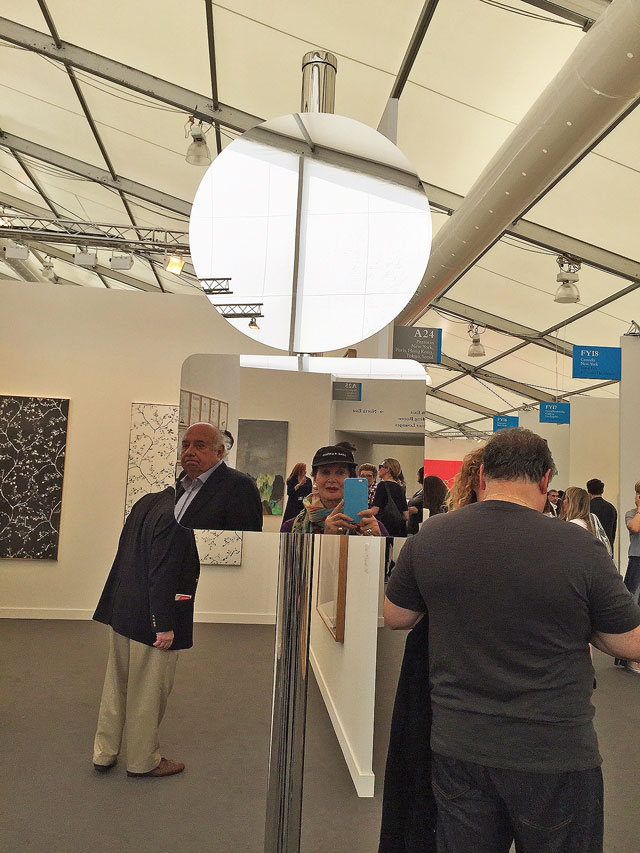
Installation view. Photograph: Jill Spalding.
Sometimes successfully, but more often not, gallerists long associated with blue-chip material sought to attract them with come-hither work that jarred out of context. The wall caption disclosing that Untitled (2013), a pink organism by the young Brazilian artist Maria Nepomuceno, was built of beaded drainpipe, ceramic, fibreglass, rope, resin and braided straw may have given Victoria Miro bragging rights, but had trouble holding its own under the masterful Alice Neel.
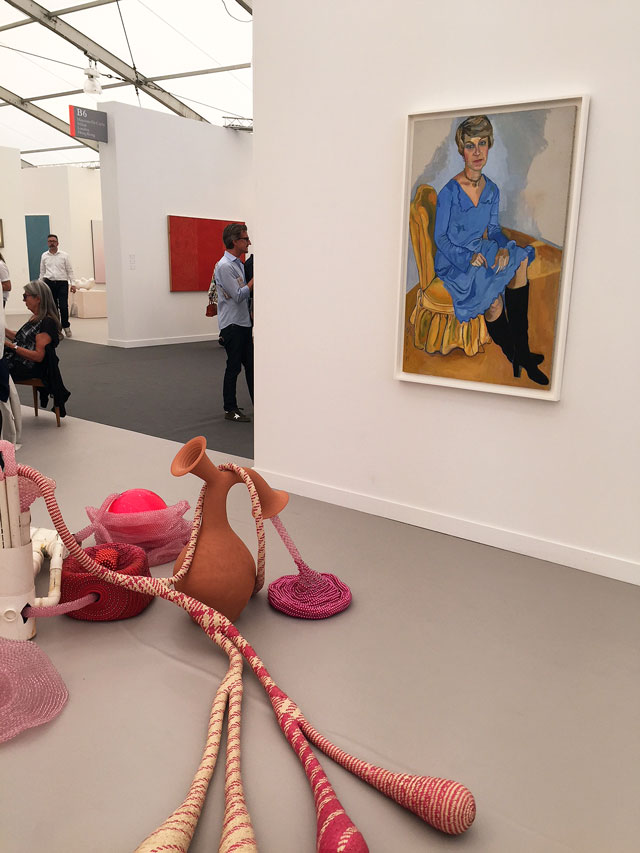
Untitled by Maria Nepomuceno under painting by Alice Neel. Photograph: Jill Spalding.
Conceptual multimedia work by female artists grown comfortable with mixing it up – much of it stitched, woven and braided – sprouted everywhere, although too urgent to be trending since most involved social commentary. At Rachel Uffner, painter Shara Hughes captured nature’s growing frailty with wire and a tangle of wool. Winning first prize at Frame for Toronto’s Cooper Cole gallery, Jamaican sculptor Tau Lewis sewed found materials into passionate expressions of black identity. Some stepped into macho territory with tougher materials. At Michael Rosenfeld, veteran artist Mary Bauermeister engaged glass, wood and canvas for “energy sculptures” that address the philosophical paradox of spiritual physicality.
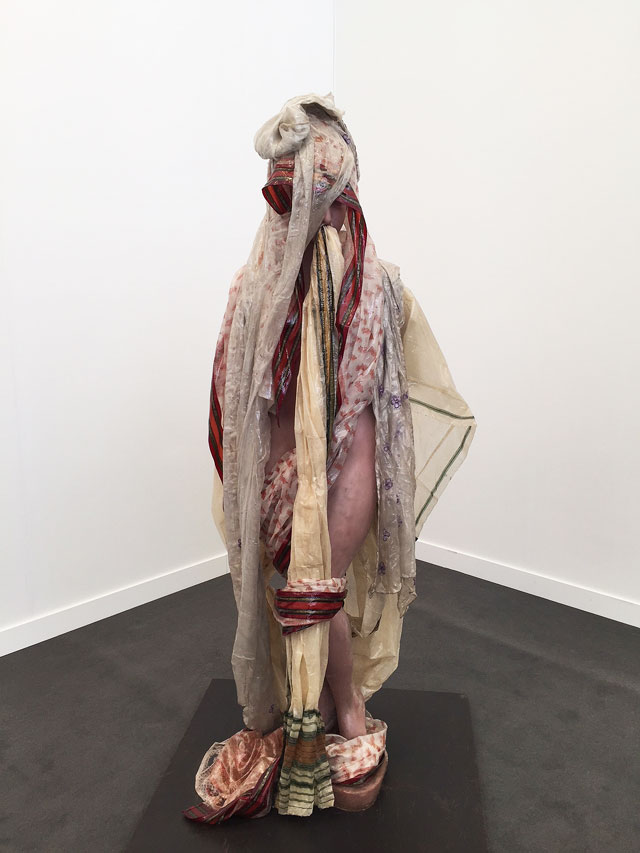
Bharti Kher. Kali, 2018. Sari, resin, metal, fibreglass. Photograph: Jill Spalding.
At Hauser & Wirth, Bharti Kher worked fabric with fibreglass to address the shifting role of India’s women. At Perrotin, Alaska transplant Paola Pivi’s I Am Adopted (2017) spun a happy tale of integration with an iron wheel gentled with feathers.
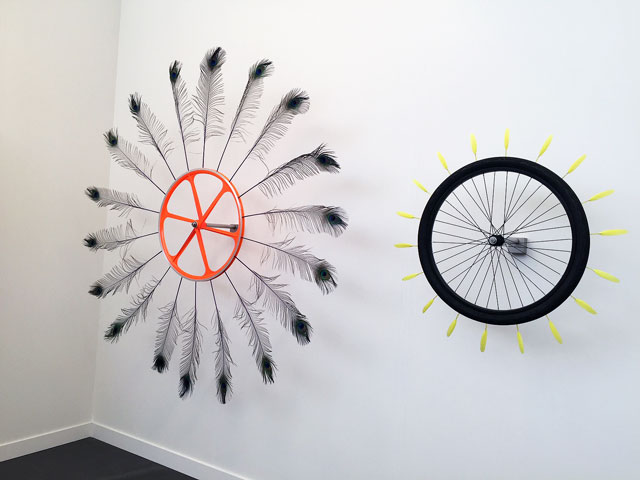
Paula Pivi. It was my choice, 2017, rubber, cast iron, engine, anser anser feathers (left); I am adopted, 2017, cast iron, engine, pavo cristatus feathers (right). Photograph: Jill Spalding.
At Tina Kim, Minouk Lim worked fabric, feathers and a ponderous camera into a disturbing preview of robotic man. Applied to standalone or wall sculptures, multiprocess intrigued. Less so, the plethora of worthy but jumbled floor confections so irritating to circumvent that I stopped noting down both artist and gallery. My problem, not theirs; although I wonder, 50 years from now, how many will survive, let alone thrive in long-term collections.
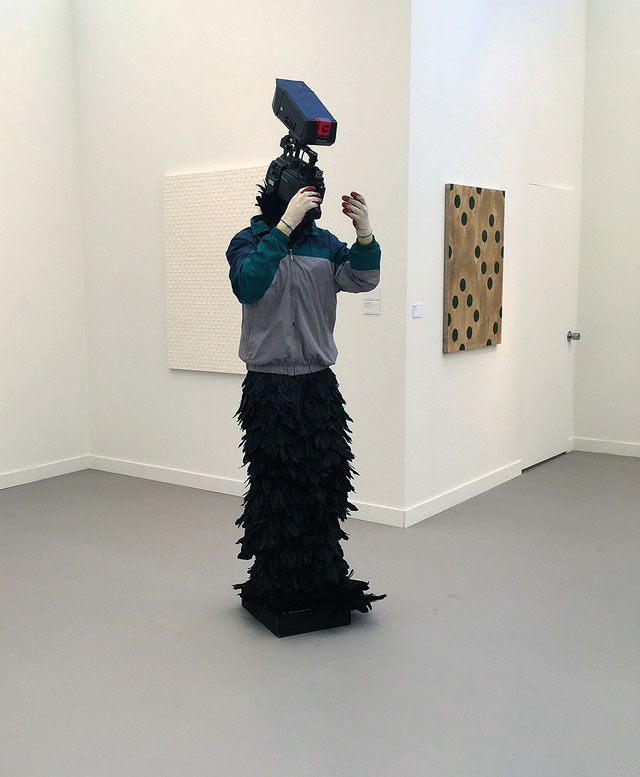
Minouk Lim. L'homme à la caméra, 2015. FRP mannequin, windbreaker, gloves, feathers, broadcast camera. Photograph: Jill Spalding.
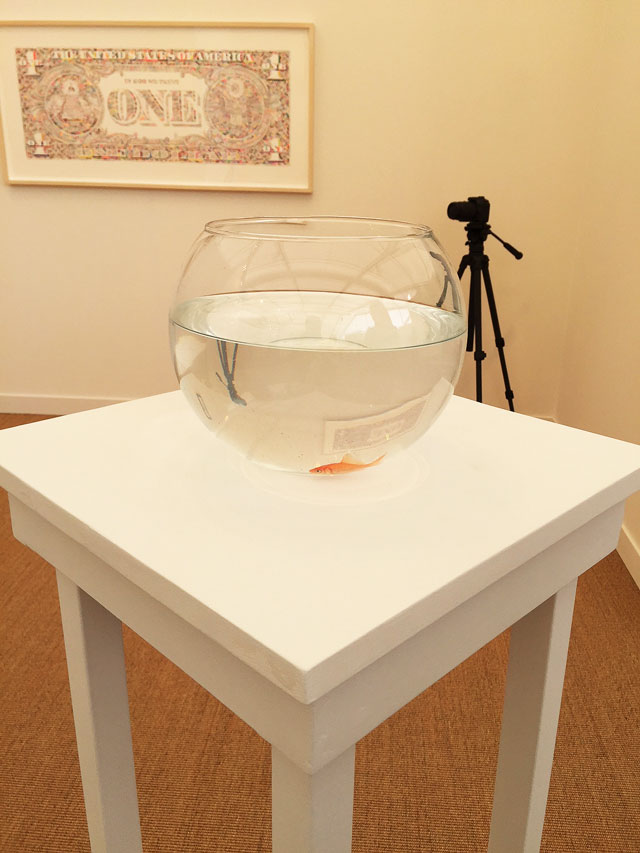
Tom Friedman. Bowl of water displaying a live goldfish. Photograph: Jill Spalding.
Dealers making their debut at Frieze – defections to Tefaf had made room for several – sought distinction with thoughtful curation. Many brought solo shows – meticulously installed. Standouts, most grouped under a stirring homage to the recently departed break-the-rules, no-first-name New York dealer, Hudson, were Takashi Murakami’s anime sculpture series installed at Gagosian, and a mini-Tom Friedman retrospective, replete with his Styrofoam-mounted Adonis and a bowl of water displaying a live goldfish that was instantly dubbed Hudson’s soul. Sound pieces abounded but did not prevail. The messages broadcast over the public address system by Chilean artist Alfredo Jaar, and the sound components of both Renée Green’s 28-banner Space Poem #5 (Years & Afters) and a vibrantly costumed work, THANK YOU/THANK YOU, by Raúl de Nieves and Erik Zajaceskowski, were drowned out by crowd speak.
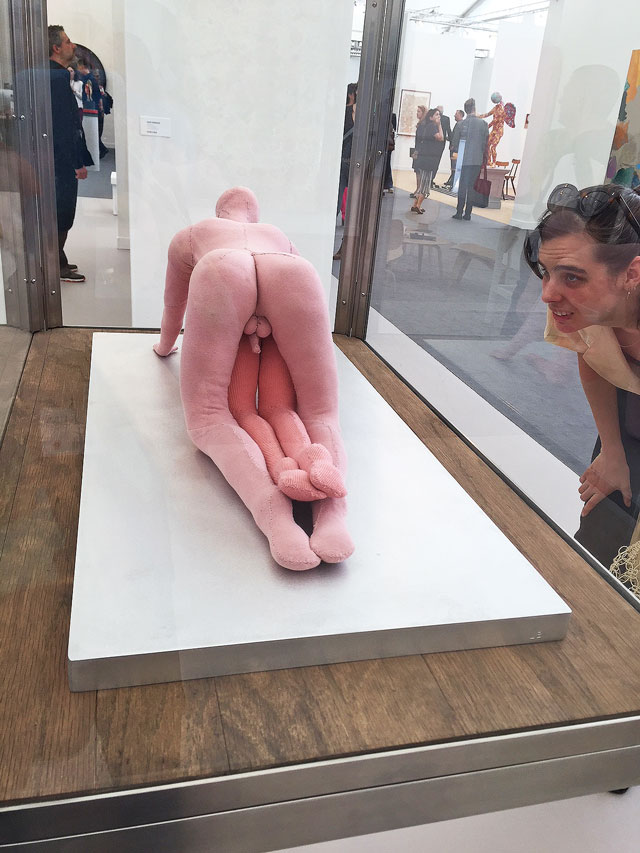
Louise Bourgeois. Couple, 2004. Fabric and stainless steel. Photograph: Jill Spalding.
Of note, what was not trending. Nothing, of course, by Chuck Close. Very little kinetic sculpture. And what has happened to video art? I counted only five works. A fear of breakdown, perhaps, and the availability of replacement discs should the artist die and the gallery fold. And is the dramatically reduced presence of photography owing to disinterest or to investment anxieties about a medium that may have a limited life and uncertain future? Also, who would have anticipated, in this #MeToo moment that excoriates sexual exploitation, so much erotic work verging on porn? Louise Bourgeois still shocked with coitus; Carroll Dunham’s new work explores frontal erection with male wrestlers going at it, so to speak, in our face; Joan Semmel’s Horizons (1981) channels the blousy sexuality of Lucian Freud (though what’s she/he doing?) and, placed close by Tom of Finland’s scatological drawings at the space dedicated to Hudson, even CK (2017) by chaste Alex Katz imparted a frisson.
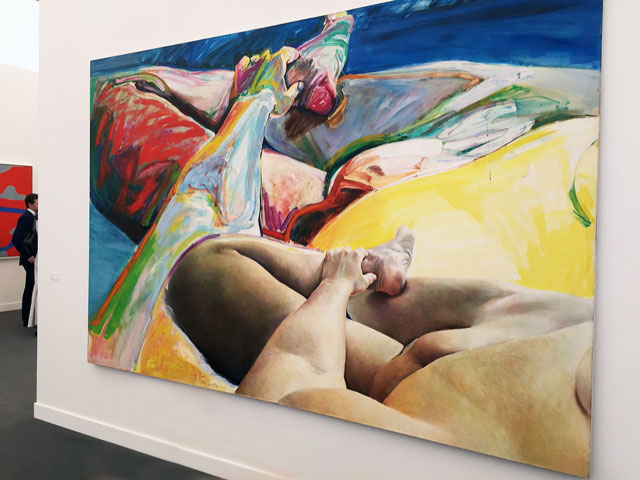
Joan Semmel. Horizons, 1981. Photograph: Jill Spalding.
It has been seven years since Frieze muscled in from London to challenge the turf of the veteran Armory Pier Show. The two months between them saved face for the one and fuelled sales of the other. Last year, though, while first over the starting line with a 24-hour lead, Frieze found itself in fierce competition with Tefaf’s newly launched Modern/Contemporary New York Spring edition. The race would have been no contest but for the patina rubbed off on the old masters champion from its decades of dominance at Maastricht. Last year, many of Manhattan’s warrior-dealers held back, waiting for the sales reports. The latter were high, so the former are here, borrowing on a gravitas that has stepped up their game.
Known for a rigor that verges on medieval, Tefaf had climbed to its august position on vetting, a process of prior and on-site verification undertaken by its team of conservators and forensic scientists beginning with connoisseurship and involving techniques now being applied to contemporary art that are so advanced as to warrant a parenthesis. (Deemed the gold standard for vetting classical and modern art, deep knowledge of the artist’s process – brushstroke, paint application, layering, rubbing, washing and so forth – were further supported by the new tools of x-ray fluorescence, infrared spectroscopy and x-radiography to more precisely date paints, paper and canvas and assess structural integrity. Now, the still newer advances addressing contemporary art can determine the uniformity, say, of the coating on outsize pieces; reveal what is called the “inherent vice”, or stability, of a material – such as masking tape that turns brittle and was intended for short-term use only; and detect fugitive pigments and alloys that will age poorly or suffer damage in bright light or outdoors. This is the level of guarantee to the collector that Tefaf Spring has brought to the New York art fair experience.)
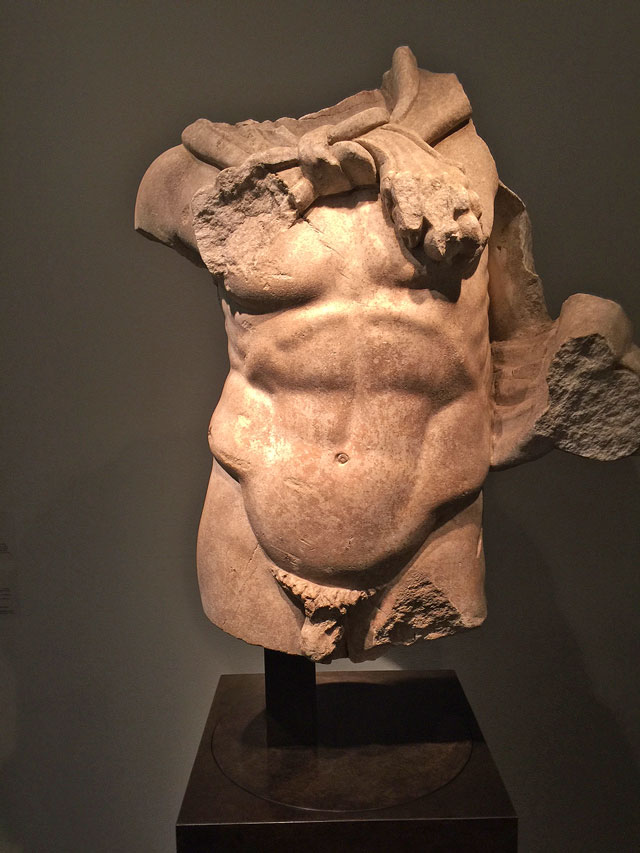
Egyptian fragmentary statue of high priest, late Dynastic Period, 26th Dynasty. Photograph: Jill Spalding.
Joined at the hip here were antiquities, antiques and the top in modern design – although most relegated to the periphery or second floor for reasons that must be financial. Did they decline to pay out for a plum space or does everything pre-Picasso price out lower? The irony played out in the superb Picasso-inspiring 1000BC Amiash zebu bull rhyton offered upstairs by London’s Charles Ede gallery, and the seeming allusions of the Barbara Hepworth at London’s Hazlitt Holland-Hibbert to the pristine Oceanic offerings at Galerie Meyer. The result of huge effort, each space had been given an atmosphere (another Tefaf trademark), painted cobalt, charcoal or Kodak yellow; wallpapered, carpeted and installed as a salon. Like the flowers livening the aisles, even the work hugging the floor (miraculous that none at Marian Goodman tripped on Gabriel Orozco’s diminutive limestone “Dice”) seemed perched on a pedestal. The overarching effect was reassuring; art as ennobling, timeless and embracing. Nothing in your face, remonstrative or scatological (excepting one famous photograph of a posterior, albeit by Man Ray.) Even the Martin Kippenberger and Niki de Saint Phalle Marilyn looked polite. Black art, elsewhere so dishearteningly co-opted for political statement, here featured as high art; case in point, the pristine oil and stick grid painting on board by McArthur Binion at Massimo de Carlo. Looking impossibly fresh were acrylics on paper by Sam Francis at Richard Gray. Expert lighting picked out an Egyptian 26th-dynasty torso and at Vallois from Paris four burnished lacquer-on-metal vases by Jean Dunand. At Zwirner a suite of Josef Albers oil on Masonite square paintings seemed to emanate their own light.
Belying “fair fatigue” and qualms about our fraying political superstructure, that dealers such as David Zwirner, Larry Gagosian and Marian Goodman booked large spaces both at Tefaf Spring and Frieze, testifies to the perceived health of the contemporary art market. That all remain cautious, nonetheless, was evidenced by the presence at all three fairs (besides top impressionists and in-the-pantheon Picasso, Matisse, Léger) of saleable artists; Josef Albers, Lygia Clark, Lucio Fontana, Wayne Thiebaud and Giorgio Morandi.
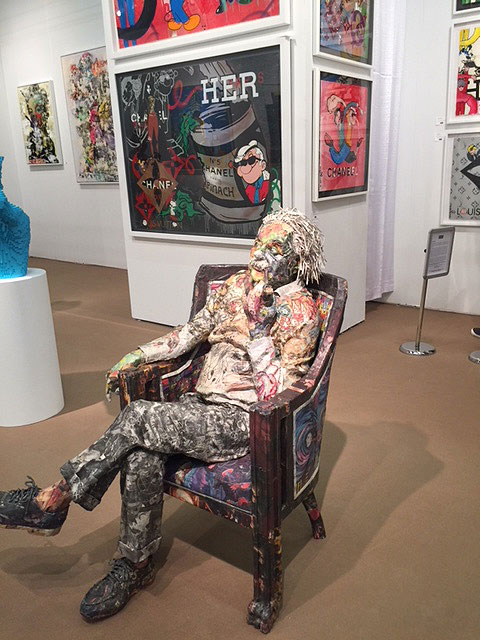
Installation view. Photograph: Jill Spalding.
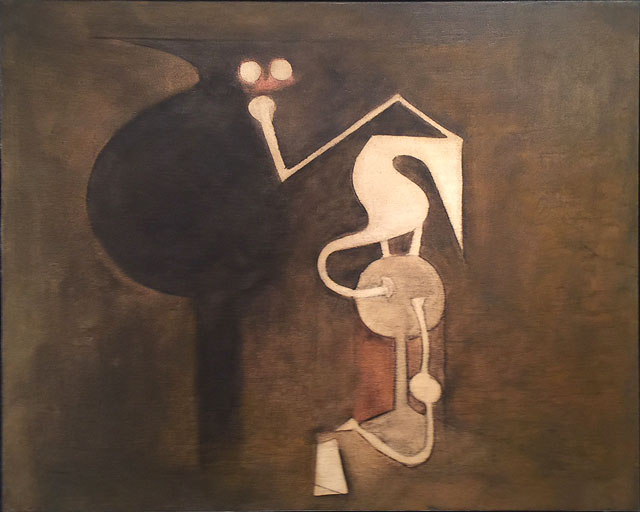
Wifredo Lam. Birds (Pájaros), c1950. Oil on canvas. Photograph: Jill Spalding.
Playing out on the fringe, although at the Armory Show-annointed Pier 94, Art New York pulled off the stunt of showing both the best and worst of what the art market will bear. Unimaginably ghastly works clad in sequins, built of marbles, painted with ketchup or glooped with plaster bookended masterworks by Wifredo Lam, desirables by Andy Warhol and seriously curated spaces like that of Archeus/Post-Modern, so refined down to a black and white peak of op art that the lone color print by David Hockney (“we have to sell something!”) appeared garish.
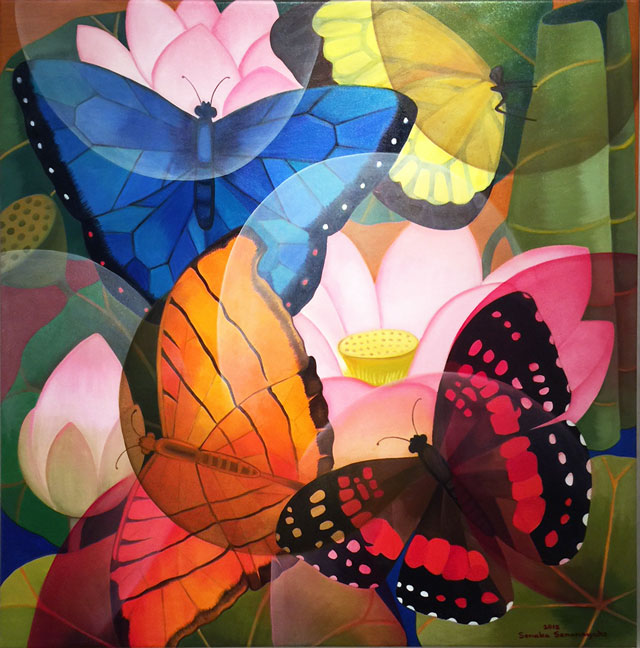
Senaka Senanayake. Lotus Butterfiles, 2018. Oil on canvas. Photograph: Jill Spalding.
A philanthropic promotion by Joe Namath drew the “see-be-seen” crowd. Long-haired high-heeled budding Asian collectors noted down work by new names such as the charming light-as-air butterfly oil painting at the Grosvenor gallery by Senaka Senanayake and took selfie-souvenirs in front of Love Struck, wrought by D*Face with “enamel and pigment based paint on medium grain cotton duck canvas”.
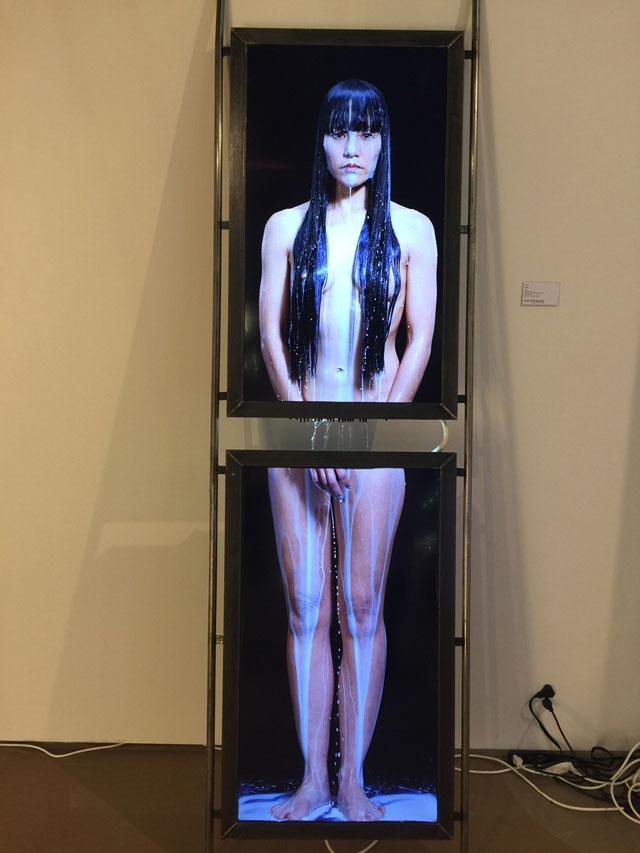
Marck. Azumi, 2015. Video sculpture. Photograph: Jill Spalding.
An ooh-ah crowd gathered in front of portraits made from corks, Marck’s video sculptures of nudes manipulated digitally to emerge from waterfalls, picture frames and sardine cans, and a gee-whiz portrait of Picasso by Kyu-Hak Lee wrought of rice paper-wrapped strips of Styrofoam, while serious collectors grouped around oil paintings of cityscapes so densely detailed as to invoke tapestries, by Turkey’s veteran Devrim Erbil, soon to be given his own museum in Istanbul; Bogatá artist Federico Uribe’s astonishing wall sculptures of animals in mid-action fashioned from shoelaces, pencils, pins and wires; and edition-bronzes by Agustín Cardenas, Arnaldo Pomodoro and Joel Shapiro.
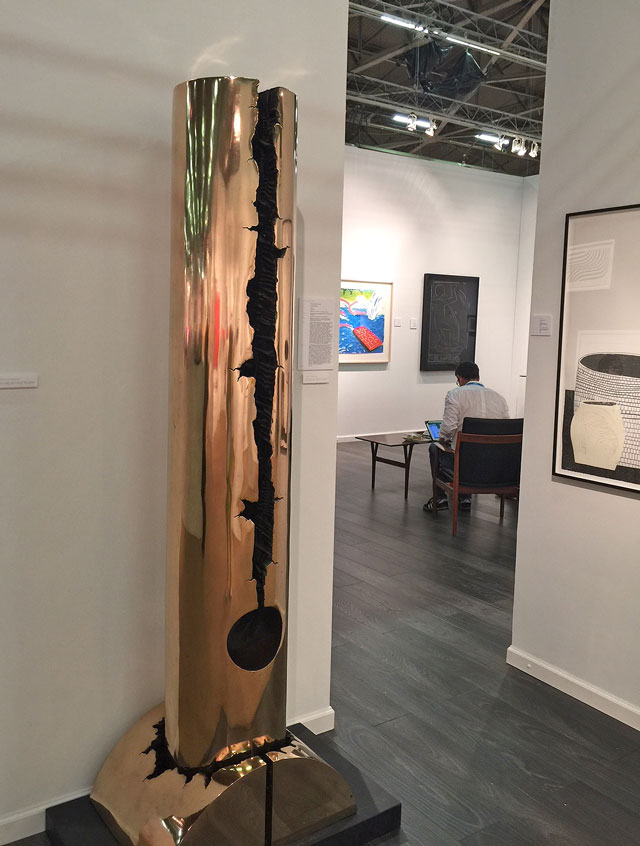
Arnaldo Pomodoro. Colonna Spaccata, 1967-8. Bronze. Photograph: Jill Spalding.
I would have checked out the satellite fairs playing out in the slowly gentrifying Brooklyn neighbourhoods of Red Hook and Bushwick – by all accounts well stocked and attended – but the batteries of my legs and my iPhone had given out. In any case, the talk of the town was the David and Peggy Rockefeller Collection on view at Christie’s – a 10-day opportunity before the five-day sale that would begin on 8 May. And what could compete with perfection? Attendance was slotted into one-hour intervals (although no evictions were reported), booked weeks ago as would be a happening. And so this great opportunity was. Although a part of the collection had been siphoned to MoMA (Abby Rockefeller’s second home) there would be no questioning the quality, the reach and the pristine condition of the works offered to benefit the philanthropic family’s favourite charities. What startled was how many of them went against type. Do you think of a Vuillard as a small, neat rectangle oil painting of fully clad ladies under beach umbrellas? Here were three giant columned watercolours of streetscapes unfolding vertically in gold frames and, two rooms over, the fiercely sectioned portrait of a man.
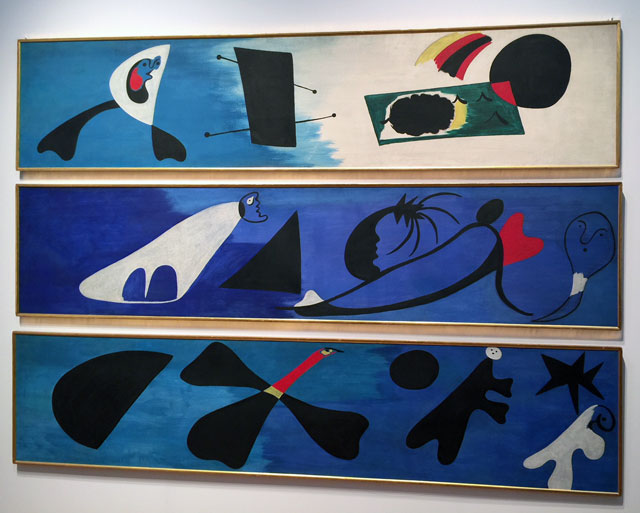
Joan Miro. Mural I, Mural II, Mural III, 1933. Photograph: Jill Spalding.
Likewise, the Miró is not the expected squared canvas, flashing surrealist shapes to the four corners, but a horizontally sectioned triptych. A Gauguin, whose paintings we expect to front figures, roils a seascape on to a fiery shore where only good eyesight reveals bathers escaping. Several Bonnard still lifes enchant but his apartment interior is the standout. Before this collection is – how it pains to imagine – dispersed forever, it should be documented and filmed as a teaching experience for young collectors to learn how it was done – pre-Instagram – by direct encounter and looking until the need to live with a work as with children and spouse transfer them to a room readied to receive them. There were also marvels from Asia, acquired with connoisseurship by both father and son. And magnificent too, of course – the welter of porcelain, crystal and marquetry, priced low as per their present fall from fashion but certain to go high with the Rockefeller imprimatur. Tossed into the muchness was a gold locket – how did no family member claim it? – holding a childhood photograph. That, together with the red Bonnard, is all that I covet.
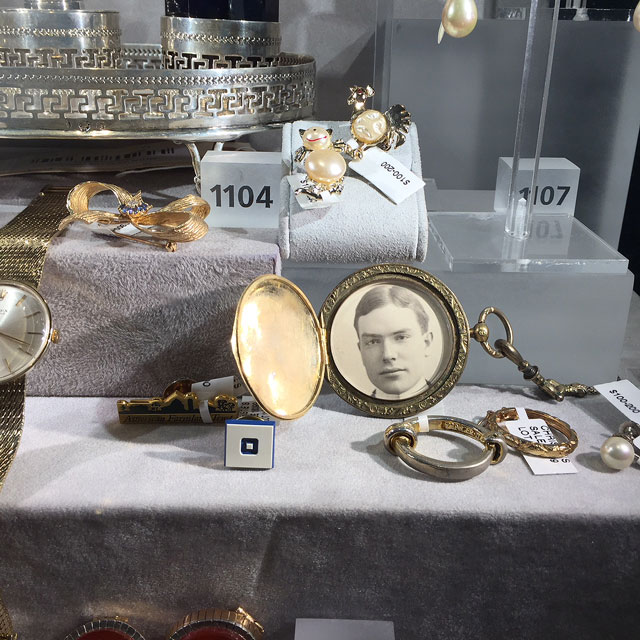
Gold locket, installation view. Photograph: Jill Spalding.